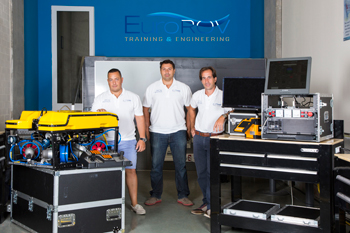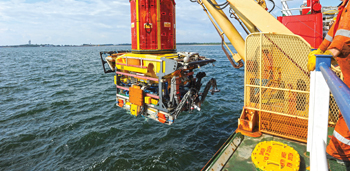
hr.jpg) Saab Seaye Leopard ROV
Saab Seaye Leopard ROV
After spending two continuous months working 24 hours a day, seven days a week, often in scorching 40-degC heat, the world’s largest underwater vehicle manufacturer’s newly delivered Leopard ROV has survived its first real test
In the Arabian Gulf, Saab Seaeye’s pioneering new Leopard electric work remotely operated vehicle (ROV) has survived its most challenging test yet.
After spending two continuous months working 24 hours a day, seven days a week, often in scorching 40-degC heat, their newly delivered Saab Seaeye Leopard ROV has survived its first real test, according to Abu Dhabi-based, CCC Underwater Engineering.
CCC Underwater Engineering, established in 1976, is a leading provider of offshore construction and subsea services to the oil and gas industry in the Middle East and Indian regions.
'It was a baptism of fire,' admits CCC’s ROV manager, Tavis Letherby, having launched the Leopard straight into a 570 kilometre pipeline inspection.
'We wanted to tease out teething problems and in the end we only needed to boost the cooling system to beat the heat. I trusted Saab Seaeye technology and the Leopard proved to be an excellent performing vehicle,' he says.
Having a large fleet of Saab Seaeye vehicles, he was keen to experience the innovative new Leopard concept, particularly as its 11 thrusters and new iCON control architecture make it the most powerful ROV of its size in the world.
'I am very impressed by its work capabilities, which in many respects are comparable to an hydraulic work vehicle,' he says.
As a rule electric scores higher than hydraulic when it comes to working in strong currents and at high temperatures – it also produces higher quality survey data. Not least are the considerable savings made in lower operating costs, ownership costs and environmental costs.
'The Leopard has a work class way of thinking.'
Having experienced the collective capability of the ROV’s new iCON control architecture and its potent tooling resource, Letherby concludes with: 'The Leopard has a work class way of thinking.'
The inspiration behind the concept, according to Saab Seaeye, was to produce a vehicle able to undertake the widest possible range of work tasks, in the most diverse environments, at the lowest cost of ownership.
Letherby explains why he is impressed: 'The Leopard can take larger tools than is usual for an electric ROV – and its third vertical thruster gives it an advantage over other ROVs.'
Turning to iCON, he says: 'An important benefit of iCON is the added functionality of station keeping, allowing the operators to concentrate on the task at hand – thereby reducing the workload on the operator and ensuring the task is performed in an efficient manner.'
Having 11 powerful thrusters also helps the Leopard stay on station when working in high current areas.
With iCON the Leopard effectively thinks for itself, leaving the operator free to concentrate on the task at hand. This comes from having refined the main electronics pod into an intelligent power distribution and data hub with the brains of the system relocated into sensors and actuators around the vehicle.
'I also like that iCON improves redundancy,' says Letherby. 'It will isolate a problem in the water and find ways around the issue to keep the vehicle working,' he adds.
The operator also gets greater information to make maintenance simpler and quicker, along with remote internet access for upgrades and support. Equipment changes are also easier, as distributed intelligence and building-block simplicity avoids the need to partially dismantle the ROV to reach a central electronic heart.
'The Leopard is a valuable option for cost savings.'
'Although the Leopard can’t do everything an hydraulic work vehicle can, it will take on most missions, including drill support, and with a 3000 metre rating, it can be a valuable option when looking for cost savings.'
 |
|
The hand-operated winch set for lowering the Falcon |
For the Middle East it has a good footprint he says. 'I find hydraulic work class vehicles too large and too heavy. The Leopard has a big advantage with its 25 tonne complete package and small footprint, when compared with the 66 tonnes of a comparable hydraulic system which has a much larger footprint, takes longer to mobilise, has a higher maintenance cost, needs more staff and needs a larger service vessel – when there aren’t many large service vessels currently operating in the Middle East.'
With CCC operating right across the region, Letherby says he uses hydraulic work vehicles alongside his fleet of Saab Seaeye ROVs that range from observation to electric work options, but is always looking for vehicles that are smarter and which lower the cost of working.
'I like that Saab Seaeye has a core construct of thought in their system design with a continuity that helps our people familiarise themselves across the range. For instance we own a Panther XT Plus light work vehicle, and are pleased to discover that the Leopard, whilst being a completely new pioneering concept has incorporated into its design some of the proven features of the excellent Panther.'
There are other new ideas he likes in the Leopard including its large open payload bay that allows for ample tooling and survey sensors to be installed on sliding trays for rapid reconfiguration and easy maintenance.
The combination of its new chassis design together with iCON and its building-block capability means that more interchangeable equipment can be fitted than ever before in a vehicle of this size.
More demanding payloads can also be added, as the Leopard has a one tonne through-frame-lift capability and a four point docking system for tooling skids.
Throughout the trialling process in the Gulf, Letherby praised Saab Seaeye support.
'It’s easy to buy an ROV system, but to operate and maintain it is something else, and I know I can rely upon Saab Seaeye’s after sales care, which succeeds where others fail,' he says.
He concludes by saying that the Leopard will be a very good match for CCC Underwater Engineering’s ROV operations across its wide range of tasks.
CAMPER COMFORT FOR TEAM
Meanwhile, the company’s another product Falcon ROV survived yet another test – this time in extreme cold weather.
Working in minus ten degrees centigrade high up in the French Alps, the Jifmar team found that the most comfortable and convenient way to inspect the Tignes Dam was to load their Saab Seaeye Falcon ROV system and themselves into a recreational camper.
Jean-Baptiste Loiselet, ROV operations manager at Jifmar, the offshore service and dam inspection company explains why the camper makes an ideal mobile base station.
'The Falcon is small enough to easily mobilise and we can contain the whole system and ourselves on board the camper for working in remote locations without facilities, and at the end of the day just stow-up and head to a nearby hotel for the night.'
The mission, just completed by the Jifmar team, was to assess the integrity of the dam wall and structures such as water inlets, and measure the amount of sedimentation at the bottom of the wall
To achieve the tasks they integrated a wide range of equipment onto the Falcon system. This included an ARIS Explorer 3000 sonar for extra fine 2D imaging and crack detection, an acoustic positioner and an ethernet HD camera with integrated lasers for scale reference.
Jean-Baptiste Loiselet says the Falcon is small but its intelligent systems architecture and five powerful thrusters can handle a wide range of large and sophisticated equipment.
'Its fibre optic capability gives us unlimited connection possibilities. We built a small interface pod with a 24V power supply and two Ethernet bulkheads, one for the ARIS or Blueview, and one for the camera and other equipment – and we still had spare power and spare RS232 bi-directional channels and ethernet connections.'
Jifmar, with support from Saab Seaeye, also designed and created added buoyancy in the shape of an enhanced faring to provide extra payload ready for fitting a skid beneath the Falcon to carry the ARIS Explorer with its tilt and roll assembly – along with any other systems needed.
Freezing temperatures could have been a problem, as every time the ROV was pulled from the water ice froze over it, but Jean-Baptiste Loiselet knew the thrusters would keep working as they have magnetic couplings rather than moving seals.
'In thousands of hours of dive time,' he says, 'Seaeye thruster technology has proved to be the most reliable in the ROV world.'
He went on to praise the versatility of the Falcon for its easy deployment, both offshore and in the dam and hydro industry for inspection and survey operations, including long tunnel work.
'Along with all its capabilities it’s still small enough to launch from a hand operated winch, and be sent into difficult-to-access locations, down small pipes and along 1100 metres of tunnel.'
The leader in the hydro market in France, Jifmar is expanding its activities worldwide, providing full inspection packages offering a range of services including 3D modelling of structures, sedimentation and lake volumes using Blueview BV5000 sonars, R2Sonic multibeams and sub-bottom profilers.
Jifmar’s extensive expertise in dam inspection comes alongside their global offshore services experience where, in addition to their fleet of vessels, they have a fleet of Saab Seaeye ROVs including three Cougars and two Falcons.
Saab Seaeye is the world’s largest electric underwater vehicle manufacturer and technology leader with the most advanced range of tethered, autonomous and hybrid vehicle systems. Vehicles, tooling and robotic solutions are engineered to address the diverse range of underwater tasks found across commercial, defence and scientific markets.
Jifmar Offshore Services offer turnkey solutions for the energy, defence and hydro industry on a worldwide basis. They have expertise in ship ownership and management, ROV operations and marine engineering services.











































































